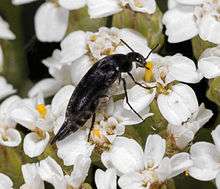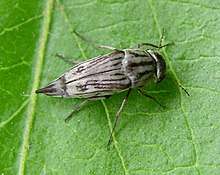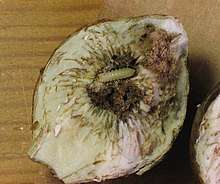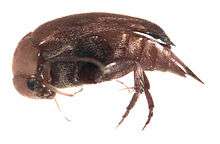Mordellidae
The Mordellidae are a family of beetles commonly known as tumbling flower beetles for the typical irregular movements they make when escaping predators, or as pintail beetles due to their abdominal tip which aids them in performing these tumbling movements. Worldwide, there are about 1500 species.[1]
| Mordellidae | |
|---|---|
 | |
| Mordella aculeata; note the "pintail" | |
| Scientific classification | |
| Kingdom: | Animalia |
| Phylum: | Arthropoda |
| Class: | Insecta |
| Order: | Coleoptera |
| Suborder: | Polyphaga |
| Infraorder: | Cucujiformia |
| Superfamily: | Tenebrionoidea |
| Family: | Mordellidae Latreille, 1802 |
| Subfamilies | |
| |
| Synonyms | |
|
Liaoximordellidae | |
Anatomy
The apparently tumbling movements are composed of a series of very rapid separate jumps (each jump of a duration of approximately 80 ms). They result from the beetle's efforts to get itself back into take-off position for flight when it has been in either lateral or dorsal position. Each individual jump should be considered as an extended rotation, performed by one leg of the third leg pair (metapodium). Depending on whether the left or the right metapodium is used as the leg that provides the leverage for take-off, change occurs in the direction of the jump. The energy for propulsion varies with the beetle's immediate muscle work, so that jump lengths and heights vary, with rotation frequencies recorded up to 48 per second (Mordellochroa abdominalis) around the gravitation centre of the body's longitudinal axis. Additional revolving around the transverse axis (at lower frequency) effects spiralling somersaults that are perceived as tumbling. The pintail (pygidium) is of no significance for the jump. While the pintail is no significance for the jump, meta-trochanter-femur (thighs and surrounding rings of the third leg pair)has a great capacity of free rotation (up to 270 degrees, at one level only). This capacity is due to a screw joint that connects the base of metacoxa to the head of trochanter. The nut gradient is 21 degrees (as seen under a scanning electron microscopy SEM, 1985). Technically similar jumps, though less powerful, can be observed in family Melandryidae (=Serropalpidae) (genus Orchesia) and family Scraptiidae (genus Anaspis). Their coxa-trochanter-joints are of similar structure. It can be assumed that the capacity of a tumbling form of locomotion is rooted in a common phylogeny and can therefore not be ascribed specifically to Mordellidae.[2] Meanwhile, other authors have also pointed out the speciality of the real screw joint in nature. (2011) The weevil of the genus Trigonopterus, Curculionidae in the Asian tropical rainforest, for example, has an even tighter connective construction in the Coxa -Trochanter joint than is found in Mordellidae. This construction, however, does not facilitate an equally high angular velocity of the torque. The joint here serves to provide a better grip on plants and easier climbing.[3]
Systematics



This family has two living subfamilies – Mordellinae and Ctenidiinae – and a prehistoric one known only from fossils (Praemordellinae).[4] Another fossil genus, Liaoximordella, was previously treated as distinct monotypic family Liaoximordellidae, but is now regarded as very primitive and probably basal member of the Mordellidae.
FAMILY Mordellidae Latreille, 1802
- Subfamily Ctenidiinae Franciscolo, 1951
- Ctenidia Laporte de Castelnau in Brullé, 1840
- Subfamily Mordellinae Latreille, 1802
- Tribe Conaliini Ermisch, 1956
- Conalia Mulsant & Rey, 1858
- Conaliamorpha Ermisch, 1968
- Glipodes LeConte, 1862
- Isotrilophus Liljeblad, 1945
- Ophthalmoconalia Ermisch, 1968
- Paraconalia Ermisch, 1968
- Pseudoconalia Ermisch, 1950
- Stenoconalia Ermisch, 1967
- Xanthoconalia Franciscolo, 1942
- Tribe Mordellini Siedlitz, 1875
- Adelptes Franciscolo, 1965
- †Asiamordella Hong, 2002
- Austromordella Ermisch, 1950
- Binaghia Franciscolo, 1943
- Boatia Franciscolo, 1985
- Caffromorda Franciscolo, 1952
- Calycina Blair, 1922
- Cephaloglipa Franciscolo, 1952
- Congomorda Ermisch, 1955
- Cothurus Champion, 1891
- †Cretanaspis Huang & Yang, 1999
- Curtimorda Méquignon, 1946
- Glipa LeConte, 1859
- Glipidiomorpha Franciscolo, 1952
- Hoshihananomia Kônô, 1935
- Iberomorda Méquignon, 1946
- Ideorhipistena Franciscolo, 2000
- Klapperichimorda Ermisch, 1968
- Larinomorda Ermisch, 1968
- †Liaoximordella Wang, 1993
- Machairophora Franciscolo, 1943
- Macrotomoxia Píc, 1922
- †Mirimordella Liu, Lu & Ren, 2007
- Mordella Linnaeus, 1758
- Mordellina Schilsky, 1908[5]
- Mordellapygium Ray, 1930
- Mordellaria Ermisch, 1950
- Mordelloides Ray, 1939
- Mordellopalpus Franciscolo, 1955
- Neocurtimorda Franciscolo, 1950
- Neotomoxia Ermisch, 1950
- Ophthalmoglipa Franciscolo, 1952
- Paramordella Píc, 1936
- Paramordellana Ermisch, 1968
- Paramordellaria Ermisch, 1968
- Paraphungia Ermisch, 1969
- Parastenomordella Ermisch, 1950
- Paratomoxia Ermisch, 1950
- Paratomoxioda Ermisch, 1954
- Phungia Píc, 1922
- Plesitomoxia Ermisch, 1955
- Praemordella Shchegoleva-Barovskaya, 1929
- Pseudomordellaria Ermisch, 1950
- Pseudotomoxia Ermisch, 1950
- Sphaeromorda Franciscolo, 1950
- Stenaliamorda Ermisch & Chûjô, 1968
- Stenomorda Ermisch, 1950
- Stenomordella Ermisch, 1941
- Stenomordellaria Ermisch, 1950
- Stenomordellariodes Ermisch, 1954
- †Succimorda Kubisz, 2001
- Tolidomordella Ermisch, 1950
- Tolidomoxia Ermisch, 1950
- Tomoxia Costa, 1854
- Tomoxioda Ermisch, 1950
- Trichotomoxia Franciscolo, 1950
- Variimorda Méquignon, 1946
- Wittmerimorda Franciscolo, 1952
- Yakuhananomia Kônô, 1935
- Zeamordella Broun, 1886
- Tribe Mordellistenini Ermisch, 1941
- Asiatolida Shiyake, 2000
- Calyce Champion, 1891
- Calycemorda Ermisch, 1969
- Calyceoidea Ermisch, 1969
- Dellamora Normand, 1916
- Diversimorda Ermisch, 1969
- Ermischiella Franciscolo, 1950
- Fahraeusiella Ermisch, 1953
- Falsomordellina Nomura, 1966
- Falsomordellistena Ermisch, 1941
- Falsopseudomoxia Franciscolo, 1965
- Glipostena Ermisch, 1941
- Glipostenoda Ermisch, 1950
- Gymnostena Franciscolo, 1950
- Mordellina Schilsky, 1908
- Mordellistena Costa, 1854
- Mordellistenalia Ermisch, 1958
- Mordellistenochroa Horák, 1982
- Mordellistenoda Ermisch, 1941
- Mordellistenula Stchegoleva-Barowskaja, 1930
- Mordellochroa Emery, 1876
- Mordellochroidea Ermisch, 1969
- Mordelloxena Franciscolo, 1950
- Morphomordellochroa Ermisch, 1969
- Neomordellistena Ermisch, 1950
- Palmorda Ermisch, 1969
- Palpomorda Ermisch, 1969
- Paramordellistena Ermisch, 1950
- Phunginus Píc, 1922
- Pselaphokentron Franciscolo, 1955
- Pseudodellamora Ermisch, 1942
- Pseudotolida Ermisch, 1950
- Raymordella Franciscolo, 1956
- Tolida Mulsant, 1856
- Tolidopalpus Ermisch, 1951
- Tolidostena Ermisch, 1942
- Uhligia Horák, 1990
- Xanthomorda Ermisch, 1968
- Tribe Reynoldsiellini Franciscolo, 1957
- Reynoldsiella Ray, 1930
- Tribe Stenaliini Franciscolo, 1956
- Brodskyella Horák, 1989
- Pselaphostena Franciscolo, 1950
- Stenalia Mulsant, 1856
- Stenaliodes Franciscolo, 1956
- Tribe Conaliini Ermisch, 1956
References
- Michael A. Ivie (2002). "Mordellidae". In Ross H. Arnett & Michael Charles Thomas (ed.). Polyphaga: Scarabaeoidea through Curculionoidea. American Beetles. 2. CRC Press. ISBN 978-0-8493-0954-0.
- Michael Reuter (1995). "Studies on the functional morphology of the jump in tumbling-flower beetles (Mordellidae, Coleoptera)". Acta Biologica Benrodis. 7: 99–133. ISSN 0177-9214.
- Van De Kamp, T.; Vagovic, P.; Baumbach, T.; Riedel, A. (2011). "A Biological Screw in a Beetle's Leg". Science. 333 (6038): 52. Bibcode:2011Sci...333...52V. doi:10.1126/science.1204245. PMID 21719669.
- Mordellidae Species List at Joel Hallan's Biology Catalog. Texas A&M University, archived from the original on 7 October 2014, retrieved 8 August 2015
- Horák, Jan; Farkac, Jan; Nakládal, Oto (2012). "Mordellidae (Coleoptera) from Socotra Island" (PDF). Acta Entomologica Musei Nationalis Pragae. 52 (supplementum 2): 253–268. ISSN 0374-1036. Retrieved 5 February 2013.
External links
| Wikimedia Commons has media related to Mordellidae. |
| Wikispecies has information related to Mordellidae |